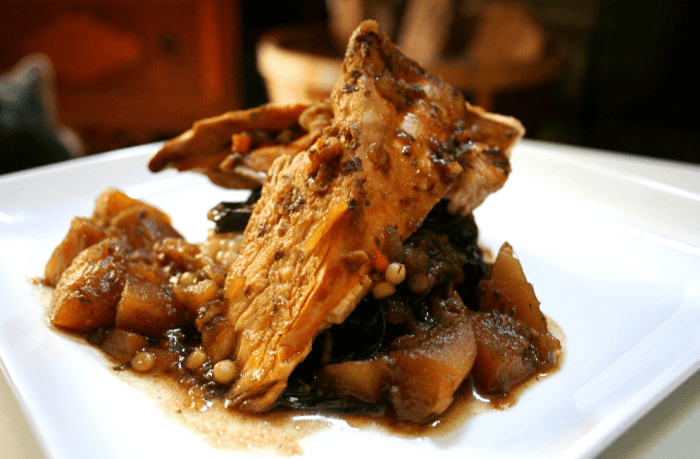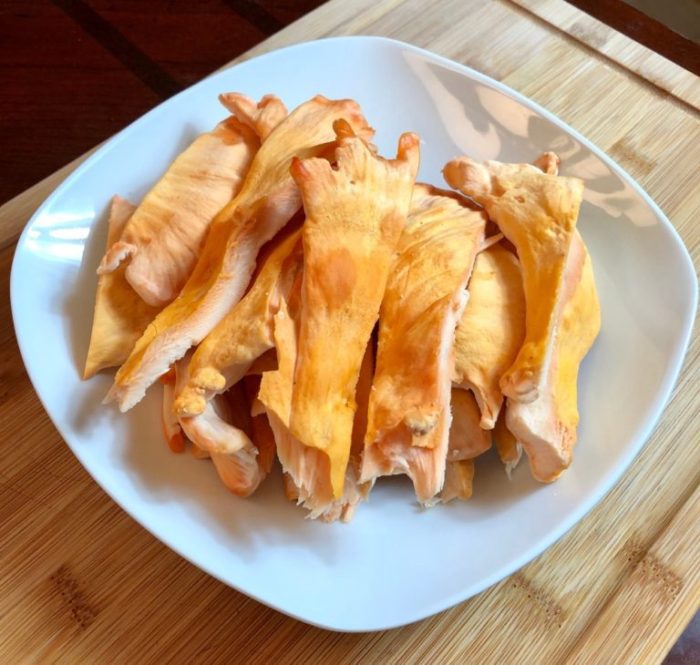
Unleash the magic of the forest with our chicken of the woods recipe guide! This extraordinary mushroom, boasting a vibrant orange hue and a meaty texture, is a culinary treasure waiting to be discovered. Dive into the world of chicken of the woods and prepare to tantalize your taste buds with innovative recipes and fascinating insights.
Introduction to Chicken of the Woods
Chicken of the woods is a type of edible mushroom known for its unique chicken-like flavor and texture. It is a shelf fungus that grows on the sides of trees, often in clusters. The mushroom has a bright orange color and a meaty texture, making it a popular choice for vegetarian and vegan dishes.
Chicken of the woods is not only delicious but also nutritious. It is a good source of protein, fiber, and vitamins, including vitamin C and potassium. The mushroom also contains antioxidants, which can help protect the body against damage from free radicals.
History of Culinary Use
Chicken of the woods has been used in culinary dishes for centuries. It was first documented in Europe in the 16th century, and it has since become a popular ingredient in many cuisines around the world. The mushroom is often used in soups, stews, and stir-fries, and it can also be grilled or roasted.
Harvesting and Preparation Techniques: Chicken Of The Woods Recipe

Harvesting chicken of the woods at its prime ensures optimal flavor and texture. The ideal time is in the fall, when the mushrooms are young and tender. Look for specimens with firm, fleshy caps and avoid those that are slimy or have signs of decay.
To harvest, carefully cut the mushroom at the base, leaving the root intact to prevent damage to the mycelium and allow for future growth.
Cleaning and Trimming
Before cooking, clean the chicken of the woods thoroughly. Use a soft brush or damp cloth to remove any dirt or debris from the surface. Trim away any tough or woody parts, such as the stem base. Slice the mushroom into bite-sized pieces for even cooking.
If you’re looking for a delicious and nutritious meal, look no further than chicken of the woods . This edible mushroom is a great source of protein and fiber, and it has a savory flavor that pairs well with a variety of dishes.
Check out this recipe for a simple and delicious way to prepare chicken of the woods.
Safety Precautions
When foraging for chicken of the woods, it’s crucial to avoid poisonous look-alikes. The most common look-alike is the Jack-o’-lantern mushroom, which has a similar orange color but is toxic. To differentiate between the two, check the gills: chicken of the woods has white or cream-colored gills, while the Jack-o’-lantern mushroom has orange or yellow gills.
Additionally, chicken of the woods has a distinct, slightly fruity scent, while the Jack-o’-lantern mushroom has an unpleasant odor.
If you’re an avid mushroom hunter, you’ve probably come across chicken of the woods . This vibrant mushroom is a culinary delight, and it’s surprisingly easy to prepare. Here’s a recipe that will help you make the most of this delicious fungus.
Culinary Applications and Recipe Ideas
Chicken of the woods is a versatile mushroom that can be cooked in a variety of ways. It can be sautéed, roasted, grilled, or pickled. Each cooking method brings out different flavors and textures of the mushroom. Here are some original and innovative recipe ideas that highlight the mushroom’s versatility:
Sautéing
- Sauté chicken of the woods in butter or oil until browned and tender.
- Add garlic, shallots, or other herbs and spices to taste.
- Serve over pasta, rice, or polenta.
Roasting
- Toss chicken of the woods with olive oil, salt, and pepper.
- Roast in a preheated oven at 400 degrees Fahrenheit for 20-30 minutes, or until tender and browned.
- Serve as a side dish or add to soups, stews, or casseroles.
Grilling
- Brush chicken of the woods with olive oil and season with salt and pepper.
- Grill over medium heat for 5-7 minutes per side, or until tender and charred.
- Serve as a side dish or on top of burgers, pizzas, or salads.
Pickling
- Combine chicken of the woods, vinegar, water, sugar, and spices in a jar.
- Let stand for at least 24 hours before eating.
- Use pickled chicken of the woods as a condiment on sandwiches, salads, or tacos.
Nutritional Profile and Health Benefits
Chicken of the woods boasts an impressive nutritional profile, offering a rich source of protein, fiber, and antioxidants.
One serving (100 grams) of chicken of the woods contains approximately:
- Protein: 12 grams
- Fiber: 7 grams
- Antioxidants: Beta-glucans, ergothioneine, and polyphenols
These nutrients contribute to several potential health benefits, including:
Improved Immunity, Chicken of the woods recipe
The beta-glucans found in chicken of the woods have been shown to stimulate the immune system, enhancing the body’s ability to fight off infections and diseases.
Reduced Inflammation
Ergothioneine and polyphenols are potent antioxidants that have anti-inflammatory properties. Consuming chicken of the woods may help reduce inflammation throughout the body, potentially alleviating conditions like arthritis and heart disease.
Sustainability and Conservation

Chicken of the woods, a prized culinary delicacy, faces potential threats to its habitat and populations. Sustainable harvesting practices are paramount to preserve this delectable mushroom for future generations.
One significant threat is habitat loss due to deforestation and urbanization. These activities fragment and reduce the mushroom’s natural habitat, limiting its growth and reproduction. Additionally, pollution from agricultural runoff and industrial waste can contaminate the soil and water sources where chicken of the woods thrives.
Responsible Foraging
- Harvest only mature mushrooms that are fully developed and easily identifiable.
- Cut the mushroom at its base, leaving the mycelium intact to allow for future growth.
- Take only what you need and avoid over-harvesting.
- Inform yourself about local regulations and obtain necessary permits for foraging.
Cultivation Techniques
- Chicken of the woods can be cultivated in controlled environments to reduce pressure on wild populations.
- Growers can inoculate logs or sawdust with mushroom spores and provide optimal conditions for growth.
- Cultivation helps maintain a steady supply of mushrooms while reducing the impact on natural habitats.
Last Recap

Our journey through the culinary wonders of chicken of the woods has been an unforgettable adventure. We’ve explored its unique characteristics, mastered harvesting techniques, and unearthed a treasure trove of tantalizing recipes. As we bid farewell to this magical mushroom, remember that its culinary versatility and health benefits make it a true gem in the world of gourmet delights.
Happy foraging and bon appétit!
Essential Questionnaire
What are the key characteristics of chicken of the woods?
Chicken of the woods is distinguished by its bright orange color, resembling the plumage of a rooster. It has a meaty texture and a slightly sweet flavor, making it a versatile ingredient in various culinary creations.
How do I harvest chicken of the woods safely?
Harvest chicken of the woods when it’s young and tender, typically in the spring or fall. Avoid mushrooms that are old, slimy, or have a foul odor. Always consult a field guide or consult with an expert to confirm identification.
Can I cultivate chicken of the woods at home?
Yes, chicken of the woods can be cultivated on logs or sawdust substrates. However, it’s important to note that the process requires patience and specific growing conditions. Research and consult with experienced mushroom growers for successful cultivation.





